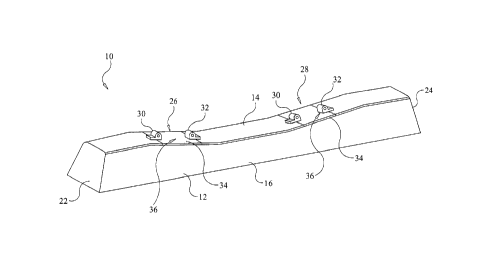Some of the information on this Web page has been provided by external sources. The Government of Canada is not responsible for the accuracy, reliability or currency of the information supplied by external sources. Users wishing to rely upon this information should consult directly with the source of the information. Content provided by external sources is not subject to official languages, privacy and accessibility requirements.
Any discrepancies in the text and image of the Claims and Abstract are due to differing posting times. Text of the Claims and Abstract are posted:
| (12) Patent: | (11) CA 2964705 |
|---|---|
| (54) English Title: | RAIL SEAT CROWN AND CONCRETE RAILROAD TIE HAVING THE SAME |
| (54) French Title: | COURONNE DE SIEGE DE RAIL ET ATTACHE DE CHEMIN DE FER EN BETON COMPORTANT LADITE COURONNE |
| Status: | Granted |
| (51) International Patent Classification (IPC): |
|
|---|---|
| (72) Inventors : |
|
| (73) Owners : |
|
| (71) Applicants : |
|
| (74) Agent: | CASSAN MACLEAN IP AGENCY INC. |
| (74) Associate agent: | |
| (45) Issued: | 2018-10-16 |
| (22) Filed Date: | 2017-04-20 |
| (41) Open to Public Inspection: | 2018-08-06 |
| Examination requested: | 2018-06-05 |
| Availability of licence: | N/A |
| (25) Language of filing: | English |
| Patent Cooperation Treaty (PCT): | No |
|---|
| (30) Application Priority Data: | ||||||
|---|---|---|---|---|---|---|
|
A concrete rail tie has an elongated tie body made of a first concrete material. The elongated tie body has an elongated top surface having a shaped profile. A preformed rail seat crown made of a second concrete material is embedded in the elongated tie body and disposed at a rail seat location of the elongated tie body. The preformed rail seat crown has top side flush with and shaped to match the shaped profile of the elongated top surface of the elongated tie body. And the second concrete material has a greater compressive strength and a greater flexural strength than the first concrete material.
Une attache de rail en béton comporte un corps dattache allongé fait dun premier matériau de béton. Le corps dattache allongé comporte une surface de dessus allongée ayant un profil formé. Une couronne de siège de rail préformée faite dun deuxième matériau de béton est intégrée dans le corps dattache allongé et disposée à un emplacement de siège de rail du corps dattache allongé. La couronne de siège de rail allongée a un côté supérieur affleurant et est formée pour correspondre au profil formé de la surface supérieure allongée du corps dattache allongé. Et le deuxième matériau de béton a une force de compression supérieure et une force de flexion supérieure à celles du premier matériel de béton.
Note: Claims are shown in the official language in which they were submitted.
Note: Descriptions are shown in the official language in which they were submitted.

For a clearer understanding of the status of the application/patent presented on this page, the site Disclaimer , as well as the definitions for Patent , Administrative Status , Maintenance Fee and Payment History should be consulted.
| Title | Date |
|---|---|
| Forecasted Issue Date | 2018-10-16 |
| (22) Filed | 2017-04-20 |
| Examination Requested | 2018-06-05 |
| (41) Open to Public Inspection | 2018-08-06 |
| (45) Issued | 2018-10-16 |
There is no abandonment history.
Last Payment of $100.00 was received on 2024-04-10
Upcoming maintenance fee amounts
| Description | Date | Amount |
|---|---|---|
| Next Payment if small entity fee | 2025-04-22 | $100.00 |
| Next Payment if standard fee | 2025-04-22 | $277.00 |
Note : If the full payment has not been received on or before the date indicated, a further fee may be required which may be one of the following
Patent fees are adjusted on the 1st of January every year. The amounts above are the current amounts if received by December 31 of the current year.
Please refer to the CIPO
Patent Fees
web page to see all current fee amounts.
| Fee Type | Anniversary Year | Due Date | Amount Paid | Paid Date |
|---|---|---|---|---|
| Application Fee | $200.00 | 2017-04-20 | ||
| Request for Examination | $400.00 | 2018-06-05 | ||
| Final Fee | $150.00 | 2018-09-06 | ||
| Maintenance Fee - Patent - New Act | 2 | 2019-04-23 | $50.00 | 2019-03-26 |
| Maintenance Fee - Patent - New Act | 3 | 2020-04-20 | $50.00 | 2020-03-27 |
| Maintenance Fee - Patent - New Act | 4 | 2021-04-20 | $50.00 | 2021-03-11 |
| Maintenance Fee - Patent - New Act | 5 | 2022-04-20 | $100.00 | 2022-04-13 |
| Maintenance Fee - Patent - New Act | 6 | 2023-04-20 | $100.00 | 2023-04-03 |
| Maintenance Fee - Patent - New Act | 7 | 2024-04-22 | $100.00 | 2024-04-10 |
Note: Records showing the ownership history in alphabetical order.
| Current Owners on Record |
|---|
| MARTIN, JOHN K. |
| Past Owners on Record |
|---|
| None |